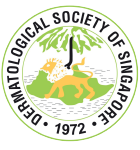Global Dermatology
Contributions from WCD2023 Ambassadors
Collection of articles about dermatology from all over the world. Dermatology beyond borders.

Perth, Western Australia
Looking forward to visiting Singapore again for the World Congress of Dermatology in 2023
It is a great pleasure to do a small write up for the potential participants of the World Congress of Dermatology to be held in Singapore 2023.
I will take you through a brief journey of my involvement with Singapore and how it has enriched my career in dermatology.
I had most of my Dermatology training in Sri Lanka. I had part of my dermatology training in Australia in 1991 and 1992. On my return to Sri Lanka, I visited the National Skin Centre, Singapore. At that time the NSC was headed by Prof Chee Leok Goh, who was known to some of my mentors in Australia. I was very impressed with the setup at the National Skin Centre. Even in 1992 their Laser set-up was very impressive.
After some years, when I got my long service leave from the Department of Health in Sri Lanka, I worked at the National Skin Centre as a consultant initially and later as a senior consultant.
My period at the National Skin Centre was a memorable period in my dermatology career. I was there from 2001-2004 and from 2005- early 2007. In 2004 I went back and worked again in Sri Lanka.
During the period I worked in Singapore I was able to kindle an interest in pigmentary disorders at the National Skin Centre as I had a passion for this area in dermatology. Prof Chee Leok Goh gave his fullest support in this effort, and we carried out many studies and published many papers on pigmentary disorders. Two bright young dermatologists with an interest in Pigmentary Disorders also blossomed in this period, Prof Stephen Thing and Dr Goh Boon Kee, who are now world-renowned pigmentary disorders experts. Prof Steven Thing is spearheading the prestigious Singapore Skin Research Centre. We also had productive collaborations with the researchers of Biopolis and the Singapore Skin Club.
During this period, I was able to publish work on progressive macular hypomelanosis, vitiligo, idiopathic guttate hypomelanosis and ashy dermatosis among other topics. In subsequent years after I moved to Australia, I continued my interest in Pigmentary Disorders.
In 2004 I was elected as the Founder President of the Asian Society for Pigment Cell Research. This meeting was held in Beijing China, during the International Congress of Dermatology in 2004. Singapore was also represented in this inaugural meeting. The first scientific meeting of the ASPCR was held in India. The ASPCR then became the 4th sister society of the International Federation of Pigment Cell Research. This was quite an achievement as none of the Asian countries other than Japan had any formal voice in the pigment cell research world.
On a request by myself, as the incumbent President of the Asian Society for Pigment Cell Research, we had the second meeting of the ASPCR in 2007 in Singapore. It was a resounding success, where a large number of pigment cell research experts from all over the world and many national and regional delegates participated. The Dermatological Society of Singapore was the other partner in organising this meeting in Singapore (Fig 1, Fig 2).


The involvement of Singapore dermatologists in pigmentary disorders research also led to holding the prestigious International Pigment Cell Conference in 2014. It was masterfully organised by Dr Goh Boon Kee. Prof Chee Leok Goh and myself were honorary Vice Presidents of this meeting.
The SARS epidemic was at its peak in Singapore in 2003. Even my wife had to be home quarantined as she had been to a surgical theater complex where a SARS patient had been there. The efficiency of Singapore became evident when Prof Chee Leok Goh spearheaded a project to produce a Colour Atlas of Dermatology during the period of SARS, when the dermatologists’ workload lessened to a great extent. I was happy to do a chapter on Pigmentary Disorders. The book was a great success. A second edition was also subsequently published. It was a clear case of making use of a difficult situation to get a useful outcome.
In July 2007 our family migrated to Singapore. I continued my close links with Singapore in my academic and other professional work. I am still a member of the Dermatological Society of Singapore.
In 2010 I was invited to deliver a talk at the First International Conference on Vitiligo held in Italy. I felt there was a need to increase awareness and help the patients of vitiligo in Australia. After I returned from that conference, I started the Vitiligo Association of Australia (VAA) and became the Inaugural President of the VAA. The association is going strong, currently headed by Dr Adrian Mar in Victoria, Australia.
In 2013 I was the convenor of the Asian Society for Pigment Cell Research Meeting. It was held in Sydney, Australia. That was also attended by a large number of national, regional and international pigment cell researchers and clinicians interested in pigmentary disorders.
With the support of Prof Davinder Parsad of Chandigarh India, I was able to gather a group of international experts on pigmentary disorders interested in acquired macular pigmentation. After several deliberations in several continents, we published the highly quoted Consensus Report on ashy dermatosis, lichen planus pigmentosus and erythema dyschromicum perstans. This paper addresses the contentious issue of terminology of acquired macular pigmentation.
In 2018 I edited and published a book on Pigmentary Disorders, published by Springer. This book had authors from 12 countries with several co-authors from Singapore as well. It was a great success. A second edition is now being planned.
The Singapore World Congress in Dermatology will be a landmark event. I am quite happy to promote this great conference in Singapore, considering the proposed scientific programme, organising capability and efficiency of the team, the cutting-edge science and technology found in Singapore, the safety and stability of the country, to hold this type of meeting.
Looking forward to seeing a large number of dermatologists from world over at the WCD 2023 in Singapore!

Professor of Dermatology at Yonsei University College of Medicine in Seoul, Korea
Nature Communications 2022 Apr 25;13(1):2214. doi: 10.1038/s41467-022-29925-x.
Weight-bearing activity impairs nuclear membrane and genome integrity via YAP activation in acral melanoma
Abstract
Acral melanoma is rare in Caucasian patients but is the most common subtype of melanoma in Asian countries. Melanoma of non-acral skin is characterized by a high mutational load due to solar UV radiation. However, in acral melanoma, which occurs mainly in areas with low UV exposure such as the sole of the foot, the mutational load is relatively low, but DNA structural variations are frequent. Little is known about the mutational processes of acral melanoma.
Nuclear envelope rupture during interphase contributes to genome instability in cancer. Our study shows that the nuclear and micronuclear membranes of melanoma cells are frequently ruptured by macroscopic mechanical stress on the plantar surface due to weight-bearing activities. The marginal region of plantar melanoma nodules exhibits increased nuclear morphological abnormalities and collagen accumulations and is more susceptible to mechanical stress than the tumor center. An increase in DNA damage coincides with nuclear membrane rupture in the tumor margin.
In this study, we developed a simple but effective experimental model for assessing the effect of macroscopic mechanical stimulation on cancer cell behaviors (Fig 1). We observed an increase in the number of cGAS- or BAF-positive nuclear blebs and micronuclei in B16F10 cells implanted into the mouse footpad compared to cells implanted into the flank skin. cGAS and BAF proteins are known to be recruited to the rupture site of the nuclear membrane. The number of cells exhibiting the DNA damage marker gamma-H2AX also increased in footpad tumors. Because weight bearing is not the only environmental factor that differs between the footpad and flank skin, we next performed forced wheel running experiments. Application of macroscopic mechanical stress for a few hours clearly induced nuclear membrane rupture and DNA damage in melanoma cells in the mouse footpad. Interestingly, nuclear membrane rupture was frequent in the marginal region of footpad tumors, and consistent with this, cGAS-positive nuclear blebs and micronuclei were observed at a higher frequency in the margin of human plantar melanoma nodules. Micronucleus rupture is a key mechanism by which DNA structural variations occur in cancer. However, oncogenes that act as major contributors to nuclear envelope instability have not yet been identified. We found that nuclear envelope integrity is compromised by the mechanosensitive transcriptional cofactor YAP activated in the tumor margin. Thus, we speculate that the mechanical stress from weight-bearing activity in plantar acral melanoma acts in two stages (Fig. 2). First, by stimulating the nuclear translocation and stabilization of YAP, it weakens the integrity of the nuclear envelope in cells undergoing tumorigenesis. Loss of RB and TP53, which is a prevalent event in human cancers, may be a prerequisite or a contributing factor for significant loss of nuclear envelope integrity. In the second stage, weakened nuclear and micronuclear membranes are damaged by sustained mechanical stress transmitted to the cancer cells. It is likely that nuclear membrane rupture is frequent in the tumor margin because the activity of YAP is particularly high at the area. Our results suggest a mutagenesis mechanism in melanoma and explain why plantar acral melanoma is frequent at higher mechanical stress points.
















